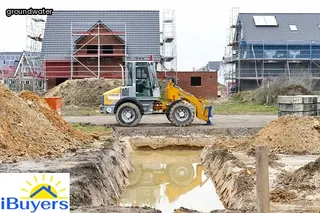Cracks in basement walls can be a warning sign of structural damage. It is essential to identify and repair these cracks as soon as possible to ensure your home’s safety.
There are several warning signs to look out for when inspecting the walls in your basement. The most common sign is when cracks appear in drywall, paint, or plaster; however, other more serious signs include bowing or leaning walls, bulging floors, and visible water seepage.
If any of these signs are present it may be a good idea to contact a professional for more advice on the best course of action. In any case, small cracks should not be ignored and should be sealed with caulk or patching compound as soon as possible before any further damage occurs.

Cracks in your basement walls can indicate a much bigger problem: damage to the foundation of your home. Catching and repairing these cracks early is essential for preventing further structural damage and costly repairs.
To help prevent cracks in your foundation, there are several simple steps you can take. Start by inspecting the exterior of your house for any signs of water damage or soil erosion and make any repairs necessary.
Inside, check for any plumbing leaks or water seepage around windows and doors. Make sure gutters are free from debris and are not overflowing, as excess water can cause erosion to the ground outside your home.
If necessary, consider installing a drainage system to help direct rainwater away from the house's foundation. Lastly, keep an eye on changes in temperature throughout the year, as this can cause expansion and contraction of soils surrounding the foundation that could lead to cracking foundations walls.
Taking these simple steps will help ensure that your basement remains crack-free for years to come.
When you spot a hairline crack in your basement wall, it can be disheartening. But don't worry - there are some simple steps you can take to repair the crack and keep it from becoming a larger problem.
Start by cleaning the area around the crack using a wire brush and vacuum cleaner to remove any dust or debris. Once clean, fill the crack with an epoxy-based filler material, applying pressure as you go to ensure that it is securely packed.
For wider cracks, use a foam backer rod for added support before filling with epoxy. Allow this to dry completely before sanding down any excess material and priming the area surrounding the repair job.
Finally, use a masonry patching compound to cover the entire area and create a smooth finish. With these simple steps, you can easily repair hairline cracks in your basement walls and protect your home from further damage.

Sealing narrow cracks in basement foundations is an important step in repairing your basement walls. Start by using a wire brush to clean the surface of the crack, then use a vacuum cleaner to remove all dust and debris.
Next, apply a concrete patching compound that is designed specifically for use on basement walls. Make sure to fill the crack completely with the patching compound, then let it dry according to the instructions on the package.
Once the patch has dried, use a trowel or putty knife to level off any excess material and feather out the edges of the patch onto the surrounding wall surface. Finally, cover the repair with a waterproof sealant that is specially formulated for use on basements walls.
This will ensure that your repairs are protected from further damage caused by water infiltration and will also provide extra stability while increasing structural integrity of your basement walls.
When repairing cracks in your basement walls, it is important to focus on the foundation wall/floor junction. If left unaddressed, these horizontal cracks can cause serious structural damage and long-term water leakage issues.
To begin the repair process, first assess the type of crack you are dealing with by examining its width and depth. Narrower cracks may only require a few simple steps for repair while wider or deeper ones may need more extensive intervention.
Use a wire brush to remove any loose material from around the crack's edges and then apply a concrete patching compound or masonry caulk with a caulking gun. Once the patch has been applied and fully dried, use a trowel to smooth out any bumps or irregularities in the surface and then repaint as necessary.
With careful attention to detail, these simple steps can help ensure that your basement wall/floor junction remains secure and leak-free for years to come.

Managing expanding foundation cracks quickly is essential for preventing further damage to your basement walls. Start by using a vacuum cleaner or brush to clear away any loose dirt or debris from the crack and around it.
Next, use a wire brush to scrub away any remaining dirt or grit that may be blocking the crack. Once you have done this, fill in the crack with an appropriate masonry sealant, such as epoxy or polyurethane.
Allow it to dry before applying a top coat of paint to help protect the wall from future water damage. Pay special attention to weatherproofing around windows and doors, as these areas are more prone to water damage and can cause the cracks in your basement wall to expand even further if not properly sealed.
Finally, if necessary, you may need to take additional steps such as hiring a professional contractor or installing extra insulation in order to fully fix the issue and prevent future cracking from occurring again.
When identifying if you have a bulging wall or large foundation crack in your basement, it is important to look for signs of outward bowing walls, horizontal cracks near the top of the wall, stair-step cracks in masonry blocks and bricks, diagonal cracks in the corners of walls, and buckling wallpapers.
Any of the above can be an indication of a bulging wall or large foundation crack.
In addition, you may notice water seepage around windows and doors leading into your basement which could also indicate a crack in the foundation.
If any of these warning signs are present it is strongly advised that you hire a professional to assess and repair your basement as soon as possible before further damage occurs.

When it comes to repairing cracks in your basement walls, the first step is to determine whether the cracks are horizontal or vertical. Horizontal foundation cracks typically occur due to pressure from the soil on the outside of the home and can be caused by a variety of factors, such as inadequate drainage around the house.
Vertical cracks are usually a result of settling and shifting foundations, which often happens when a house is built on unstable soil. It's important to differentiate between horizontal and vertical cracks because they require different repair methods.
To tell horizontal from vertical, get close to the wall and look at the direction of the crack. If it runs horizontally along the length of your wall, then it’s likely a horizontal crack.
Conversely, if it looks like it is running vertically up or down your wall, then it’s likely vertical. Knowing how to accurately identify these two types of cracks will help you decide which type of repair is necessary for fixing your basement walls.
When diagnosing directional changes in foundation cracks, it is important to understand the underlying cause. Cracks in your basement walls may be caused by a number of issues, such as structural shifting, water damage, and settling.
To properly diagnose a directional change in foundation cracks, you will need to investigate the area thoroughly. Inspect the wall for any signs of moisture and check the surrounding soil for instability or poor drainage.
If necessary, use a level to determine if there is an unevenness in the wall that could be causing a crack to appear. Foundation problems can be difficult to detect but understanding how these issues manifest can help you identify potential causes and take corrective action.
With proper diagnosis, you can repair any cracks in your basement walls quickly and cost-effectively.

A cracked foundation can be both a structural and an aesthetic issue, so it's important to follow strategies for reducing the risk of foundation damage and cracking. One of the best ways to do this is to make sure your basement walls are sealed properly.
Additionally, it's important to keep moisture levels in check, as even small amounts of moisture can cause significant damage over time. It's also a good idea to install gutters and downspouts that direct water away from your home.
It’s also essential to maintain proper grading around your home, as poor soil grading can lead to an uneven distribution of pressure on your foundation walls. Finally, if you notice any signs of distress or cracking in your foundation walls, it’s important to address them immediately by using simple repair techniques such as patching cracks with hydraulic cement.
Following these steps will help protect the integrity of your basement walls and reduce the risk of potential foundation damage and cracking.
The best way to fix basement cracks is to follow a few simple steps. First, you should identify the type of crack in your wall and determine how extensive it is.
If the crack is large or deep, it is important to repair it right away. For smaller cracks, you may be able to seal them up with a high-quality caulk or concrete patch.
Once you have identified the type of crack and chosen an appropriate repair material, the next step is to clean out any debris from within the crack and around its edges. After this has been done, you can then apply the caulk or patch according to the manufacturer's instructions.
Depending on the size of the crack, you may need multiple applications in order for it to be completely fixed. Lastly, after all of these steps have been completed, ensure that your basement wall has been properly sealed and dried before use.
Following these simple steps will help ensure that your basement walls are repaired quickly and correctly.

Cracks in basement floors should be repaired as soon as possible to maintain the structural integrity of your home. Fixing cracks in concrete basement walls is essential, not only for the safety of your family but also to preserve the value of your home.
Fortunately, repairing cracks in basement walls is a relatively simple process that can be done with a few simple steps. First, you need to clean any dust or debris from the crack using a vacuum cleaner or broom.
Then, use an epoxy filler or masonry patching material to fill the crack and allow it to dry completely. Finally, cover the patch with waterproof sealant to protect it from water damage and further cracking.
Following these simple steps will help ensure that your basement floor remains structurally sound for years to come and keep your home safe and secure.
Repairing cracks in concrete basement walls can seem like an intimidating task, but with the right materials and simple steps, you can easily repair your cracked basement walls. First, it’s important to determine the cause of the crack; if it’s due to water damage, you may need to address any water-related issues before attempting to repair the crack.
Then, use a chisel and hammer to widen the crack and remove any loose pieces of concrete from inside the crevice. Next, fill the crack with an epoxy or cement-based filler and allow it to dry completely before sanding down any excess material.
Finally, seal the area with a waterproof sealant for added protection against water damage. With these simple steps, you can quickly and easily repair cracks in your basement walls for good!.
Yes, foundation cracks can be repaired from the inside. The process of repairing a cracked basement wall is relatively simple and straightforward.
First, it’s important to clean the area around the crack to ensure that all debris is removed. Then, use a brush or vacuum cleaner to remove any remaining dirt and dust particles.
After this, apply an epoxy patching compound to the crack using a putty knife for even coverage. Allow the compound to dry completely before applying a sealant to further protect the area from moisture damage.
Finally, apply a coat of waterproof paint over the entire surface to complete the repair job and restore your basement wall’s structural integrity. With these simple steps, you can easily repair cracks in your basement walls from the inside without professional help!.